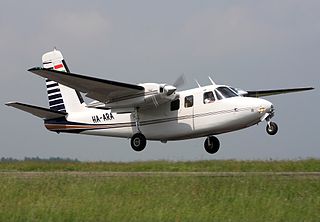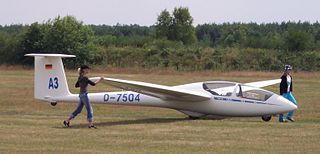This article does not cite any sources .(December 2016) (Learn how and when to remove this template message) |



The Grob G103 is a family of glass-reinforced plastic two-seat sailplanes developed in Germany by Grob Aircraft AG. The aircraft are of T-tail configuration and fitted with upper surface air brakes. They are designed for training, high performance soaring and basic aerobatic flying (Twin II Acro and Twin III Acro).

Grob Aircraft is a German aircraft manufacturer, previously known as Grob Aerospace. It has been manufacturing aircraft using carbon fiber reinforced polymer since the 1970s.
- Grob G103 Twin Astir Built since 1976, with retractable or fixed undercarriage in front of the center of gravity and water ballast.
- Grob G103a Twin II a new and unrelated design that replaced the Twin Astir from 1980, with fixed undercarriage behind the center of gravity and nose wheel.
- Grob G103c Twin III Replaced the Twin II from 1989, with a new triple-trapezoidal wing, lower control forces and higher airspeed limitations.

The Grob G 103 Twin Astir is a glass-reinforced plastic two-seat sailplane that was developed in Germany in the 1970s by Grob Aircraft AG as a counterpart to the single-seat G 102 Astir then in production. Construction throughout is similar, although to preserve the centre of gravity of the design, the wings were given a slight forward sweep. While many two-seat derivatives of single-seat sailplanes have fixed undercarriage, due to the added space restrictions created by the second seat, Grob devised a novel retraction system for the Twin Astir. The single wheel was designed to rotate 90° sideways before retracting "flat" under the rear seat, resulting in a rather unusual seating position. This was only incorporated in early examples, later on, the wheel was fixed. Factory options offered to customers included whether the front seat should be equipped with flight instruments, and whether water ballast capacity should be installed.

The G103 Twin II is a German high performance two-seater sailplane made by Grob Aircraft. The aircraft is of T-tail configuration, and is fitted with a non retractable undercarriage and upper surface airbrakes. Of glass fibre construction, it is designed for training, high performance, and simple aerobatic flying.

The G103C Twin III is a high performance tandem two-seat sailplane made by Grob Aircraft. It replaced the Twin II in production and features a new triple-trapezoidal wing, automatic elevator connection, lower control forces and higher airspeed limitations.
| This article includes a list of related items that share the same name (or similar names). If an internal link incorrectly led you here, you may wish to change the link to point directly to the intended article. |






